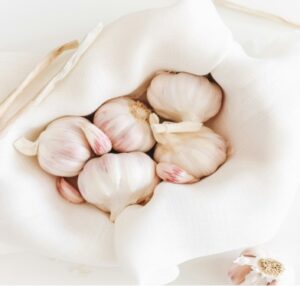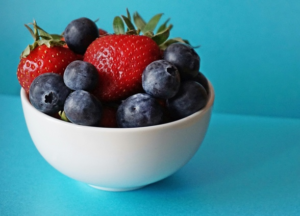
We’ve all been there. That frustrating moment staring in the mirror, battling breakouts, redness, or that persistent dullness that no amount of fancy serums seems to conquer.
We shouldn’t have to deal with the embarrassment of acne past age 20, right?
We diligently cleanse, tone, and moisturize, often feeling like we’re waging a war on our skin from the outside in. But what if the secret to a radiant complexion wasn’t just on the surface?
What if the key to clearer, healthier skin lies within the bustling metropolis of your gut?
Let’s take a look at how the world within your gut affects what you see on the outside.
Meet Your Inner Ecosystem: The Gut Microbiome
Imagine your gut as a vibrant, thriving rainforest teeming with trillions of microorganisms – bacteria, fungi, viruses, and more. This complex community, collectively known as the gut microbiome, isn’t just there to digest your food. Oh no, it’s a bustling hub of activity, playing a crucial role in everything from your immune system and nutrient absorption to even your mood (Read about how your gut affects your mood and other aspects of your brain health here.)
A healthy gut microbiome is a diverse and balanced ecosystem, where beneficial organisms outnumber the more harmful ones. When this balance is disrupted – a state called dysbiosis – it can impact your entire body, and yes, that includes your skin.
The Gut-Skin Axis: More Than Just a Gut Feeling
So, how exactly does this inner world influence the outer layer we present to the world? Scientists are still unraveling the intricate mechanisms, but several key pathways are emerging:
- Inflammation Highway: An imbalanced gut microbiome can lead to increased intestinal permeability, often referred to as “leaky gut.” This allows substances like bacterial byproducts and toxins to seep into the bloodstream, triggering a systemic inflammatory response throughout the body, including the skin. Chronic inflammation is a major culprit in various skin conditions like acne, rosacea, eczema, and psoriasis. (See the science behind this here.)
- Immune System Communication: Your gut houses a significant portion of your immune system… about 70 – 80% to be exact. The gut microbiome plays a major role in “training” and regulating immune cells. Dysbiosis can lead to an overactive or misdirected immune response, which can manifest as inflammation and skin disorders.
- Metabolic Byproducts: The bacteria in your gut produce various substances called metabolites as they break down food. Some of these metabolites, like short-chain fatty acids (SCFAs) such as butyrate, have anti-inflammatory properties and can positively influence skin health. When these anti-inflammatory species are missing, it can show up on your skin. A diverse and healthy microbiome produces a wider range of beneficial metabolites and beautiful, clear skin.
- Hormonal Harmony: And for you ladies out there, emerging research suggests a link between the gut microbiome and hormone regulation, particularly estrogen metabolism. An imbalance in gut bacteria can potentially affect estrogen levels, which in turn can influence skin conditions like hormonal acne.
The Gut Microbiome and Common Skin Concerns: The Evidence So Far
While the research is ongoing, studies are hinting at the significant role the gut microbiome might play in various skin conditions:
- Acne: Studies have shown that individuals with acne often have altered gut microbial compositions compared to those with clear skin. Increased levels of certain harmful bacteria, decreased levels of beneficial bacteria, and decreased overall diversity have been observed. Furthermore, the whole-body inflammation triggered by gut dysbiosis can exacerbate acne breakouts
In our practice, we see acne very commonly with our patients that have H. pylori infections or Candida overgrowths. Especially with Candida, these patients benefit greatly by temporarily eliminating dairy from their diet.
- Rosacea: This chronic inflammatory skin condition characterized by facial redness, flushing, and sometimes bumps and pimples, has also been linked to gut health. Some studies suggest that small intestinal bacterial overgrowth (SIBO) and an altered gut microbiome may play a role in its development and severity.
In our practice, we see a link between those patients with imbalanced gut bacteria and rosacea. In particular, inflammatory bowel disease (IBD), small intestinal bacterial overgrowth (SIBO), and H. pyloriinfection have been associated with rosacea.
- Eczema (Atopic Dermatitis): The gut microbiome of infants and children with eczema often shows lower diversity and an abundance of certain bacteria like Staphylococcus aureus. Early-life gut microbial composition is increasingly recognized as a potential factor in the development of this itchy and inflammatory skin condition. In adults, a less diverse gut microbiome is often observed in people with eczema.
In our practice, we almost always see a fungal overgrowth like Candida in patients with eczema. Nearly always. Like with acne, those patients that have a fungal overgrowth as the source of their skin condition benefit from the temporary elimination of dairy products. Many patients have been able to completely clear the eczema once they rebalance their gut microbiome.
- Psoriasis: Research suggests that individuals with psoriasis may also have alterations in their gut microbiome, with some studies indicating increased levels of certain pro-inflammatory bacteria and decreased levels of beneficial ones. The systemic inflammation associated with gut dysbiosis could contribute to the inflammatory nature of psoriasis.
Feeding Your Way to Fabulous Skin: Nurturing Your Gut Microbiome
The exciting news is that you don’t just have to deal with the skin issues. You do have control over the composition and diversity of your gut microbiome through your diet and lifestyle choices. Think of it as cultivating a beautiful inner garden that can bloom outwards onto your skin! Here’s how you can nourish your gut for a clearer complexion:
- Embrace the Rainbow (of Fruits and Vegetables): A diverse range of colorful fruits and vegetables provides a wide array of prebiotics – non-digestible fibers that act as food for your beneficial gut bacteria. Think berries, leafy greens, broccoli, carrots, and more!
- Fiber is Your Friend: Whole grains, legumes (beans, lentils), and those aforementioned fruits and veggies are packed with fiber, which fuels the good guys in your gut and promotes a healthy balance. Read more about specific types of fiber and which foods contain them in this blog post.
- Get Fermented: Incorporate fermented foods like yogurt (with live and active cultures), kefir, sauerkraut, kimchi, and kombucha into your diet. These are rich in probiotics – live beneficial bacteria that can directly contribute to a healthier gut microbiome. Try our recipe for fermented ginger applesauce. It’s seriously good and good for you!
- Consider Prebiotic-Rich Foods: Onions, garlic, asparagus, bananas, and oats are excellent sources of prebiotics that help your existing good bacteria thrive.
- Limit the Junk: Processed foods, sugary drinks, excessive alcohol, and artificial sweeteners can disrupt the delicate balance of your gut microbiome, often feeding the less beneficial bacteria and contributing to inflammation.
- Stay Hydrated: Water is essential for overall health, including maintaining a healthy gut environment and proper digestion.
- Manage Stress: Chronic stress can negatively impact your gut microbiome. Incorporate stress-reducing activities like mindfulness, yoga, or spending time in nature. Or go for a long, long walk until your boss/spouse/kids don’t annoy you.
- Consider Probiotic Supplements: While diet should be your primary focus, probiotic supplements can be helpful for some individuals. When we test our patients’ gut, we make specific recommendations based on what the test shows. If they are low in a certain species, we do recommend certain probiotics to repopulate those species.
The Takeaway: Beauty Starts Within
The connection between your gut microbiome and your skin is a fascinating and emerging field. While topical treatments play a role in addressing skin concerns, understanding and nurturing your inner ecosystem offers a powerful, holistic approach to achieving a clearer, healthier complexion.
By focusing on a gut-friendly diet rich in fiber, prebiotics, and probiotics, managing stress, and making mindful lifestyle choices, you can cultivate a thriving inner garden that may just be the missing piece in your skincare puzzle.
So, the next time you’re reaching for that serum, remember that true radiance might just begin with the trillions of tiny inhabitants working hard within you. It’s time to nourish your gut and let your inner beauty shine through!
Gut Health Diagnosis at EverVital Nutrition
Are you struggling with gut symptoms that affect your skin that you just can’t clear up? We can help!
At EverVital Nutrition, we use specific diagnostic tools to determine your level of gastrointestinal overgrowth (which is very common with patients taking GLP-1 meds, antibiotics, or antihistamines), digestive function, and inflammation. It’s a comprehensive gut microbiome test, rather than a guess.
To learn more about gut testing and get on the path to healing so you can live the life you want in beautiful skin, scan the QR code below to schedule your free gut assessment!











